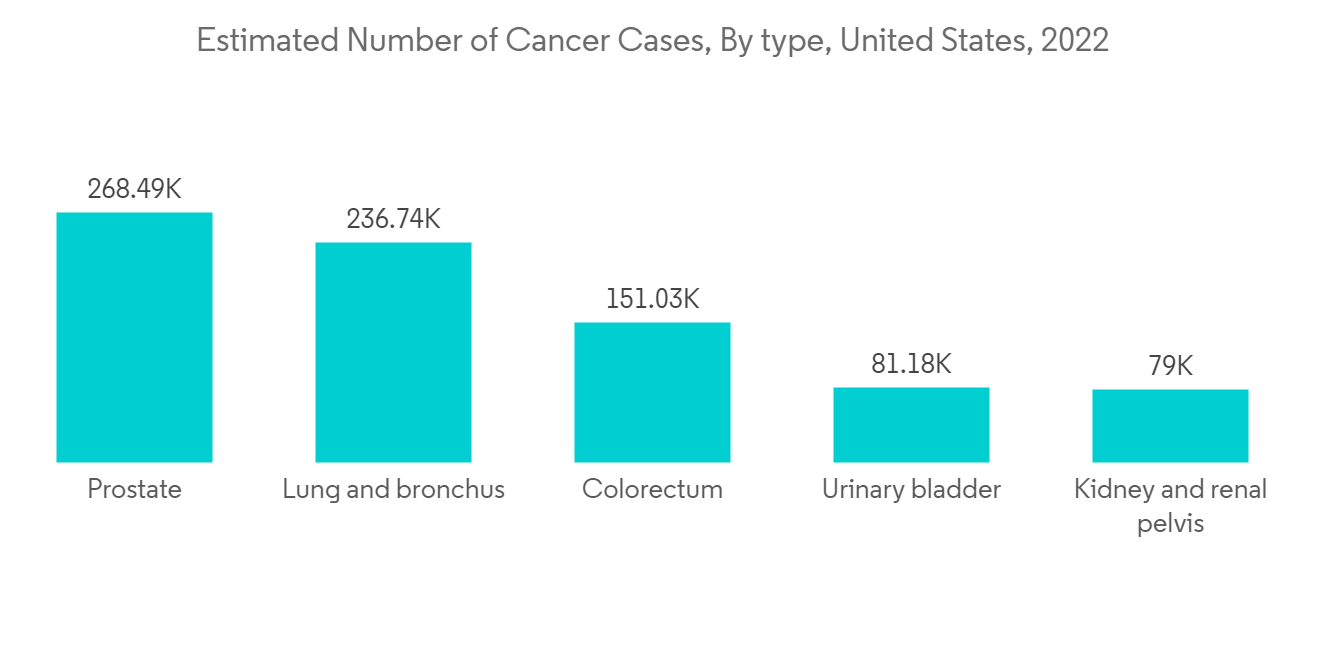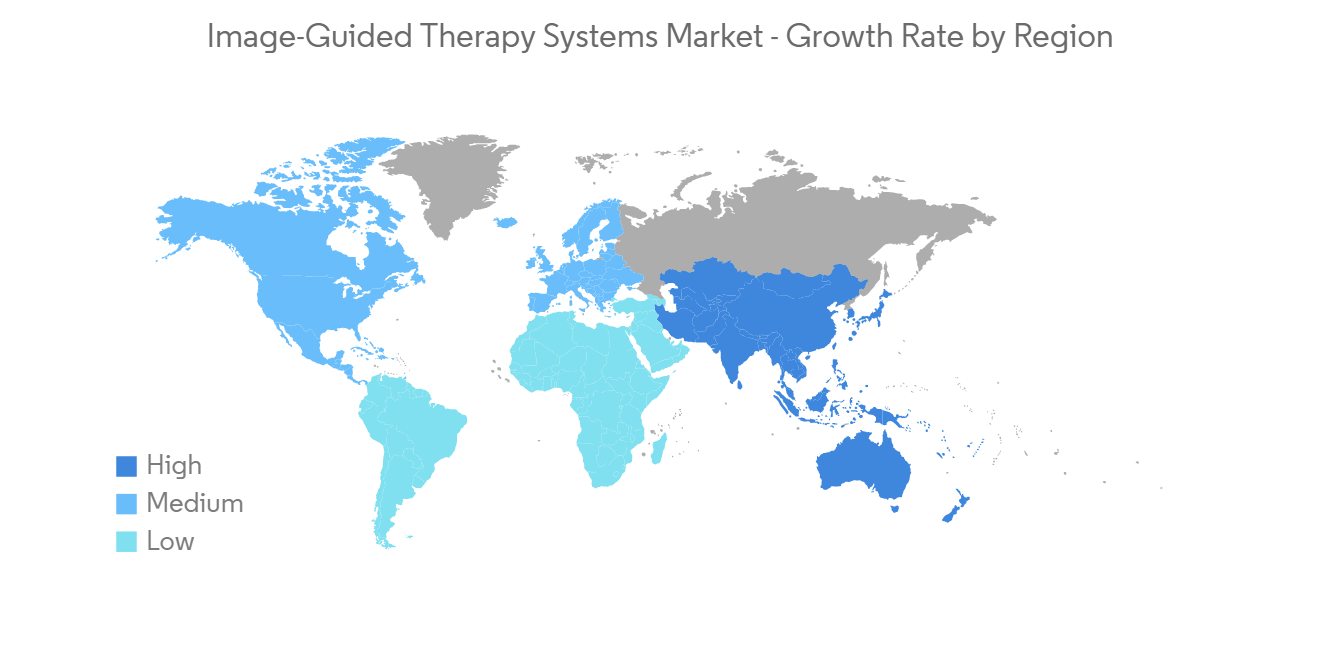 |
市場調查報告書
商品編碼
1244369
全球圖像引導治療系統市場——增長、趨勢、COVID-19 的影響和預測 (2023-2028)Image Guided Therapy System Market - Growth, Trends, and Forecasts (2023 - 2028) |
||||||
※ 本網頁內容可能與最新版本有所差異。詳細情況請與我們聯繫。
在預測期內,全球圖像引導治療系統市場預計將以 6.5% 的複合年增長率增長。
由於在 COVID 期間越來越多地採用圖像引導療法,COVID-19 在預測期內對市場增長產生了重大影響。 例如,在 2022 年 7 月發表在 RSNA 期刊上的一篇論文中,與普通人群相比,在大流行恢復期間接受圖像引導皮質類固醇注射以控制疼痛的成年人出現症狀的可能性要小得多。提到-19。 影像引導關節注射是一種具有抗炎作用的類固醇藥物注射,通過透視和超聲波來精確定位進針位置並顯示進針進度。 此外,由於慢性病的增加、老年人口的增加以及癌症放射治療的激增,預計未來幾年圖像引導治療系統市場將出現增長。 例如,根據 2022 年 2 月發表的一篇論文,圖像引導手術可以通過允許外科醫生優化手術方法來促進腫瘤學安全並減少胃癌手術的並發症。一項新的發展顯示了使用術中高光譜成像的前景 ( HSI)在術中組織診斷中的應用。
有幾個因素正在推動圖像引導治療系統的發展,包括人口老齡化、慢性病負擔增加以及癌症放射治療工作的增加。 例如,根據美國癌症協會 2022 年更新,2022 年美國估計將有 190 萬新癌症病例。 因此,癌症患者的高患病率導致對微創外科手術的需求增加,從而有助於預測期內圖像引導治療系統市場的增長。
此外,影像引導治療方面的研究合作、合作夥伴關係和產品發布預計將在預測期內推動市場增長。 例如,2021 年 8 月,皇家飛利浦與 MedTech 中風護理公司 NICO.LAB 簽署協議,為飛利浦圖像引導治療系統 Azurion 開發新的中風功能。 這一新的合作夥伴關係凸顯了飛利浦致力於為中風患者帶來改變的決心。 此外,2021 年 2 月,飛利浦推出了脊柱手術圖像引導治療解決方案 ClarifEye 增強現實手術導航。 該解決方案旨在推進飛利浦 Hybrid Suite 等混合手術室中的微創脊柱手術。
此外,由於老年人口增多,高血壓、高血脂、癌症等多種慢性病發生的可能性很大。 例如,WPP 2022年發布的數據預測,到2050年,全球65歲及以上人口數量將是5歲以下兒童數量的兩倍以上,與5歲以下兒童數量幾乎持平。 12歲。它已經。 此外,微創圖像引導治療方法是首選,因為它們可以減少術後並發症並降低醫療費用。
因此,由於慢性病的增加、老年人口的高患病率以及微創手術的普及,預計圖像引導治療系統市場將在預測期內推動增長。
圖像引導治療系統市場趨勢
內窺鏡領域有望佔據影像引導治療市場的很大份額
在影像引導治療系統市場中,內窺鏡系統領域由於癌症和胃腸道疾病的增加等因素有望增長。 根據國際胃腸道疾病基金會 2022 年更新,估計全球 5-10% 的人口患有炎症性腸病。 據估計,美國每年有 2.4 至 350 萬胃腸病學家就診。 這些因素有望推動圖像引導治療系統的採用,並促進該領域的發展。 此外,大量內窺鏡引導手術和越來越多地採用機器人輔助內窺鏡引導手術進行診斷也是推動市場的重要因素。
此外,技術先進的內窺鏡以及許多產品的開發和發布已經成為內窺鏡領域的導火索。 例如,2022 年 8 月,美敦力推出了 GI Genius,這是一種用於治療結腸癌的人工智能驅動內窺鏡模塊。 由於這些療法在神經病學、放射腫瘤學和創傷治療中的廣泛使用,磁共振圖像引導治療領域也出現了顯著的市場增長。 此外,2022 年 2 月,Ambu 在美國獲得了 FDA 對 Ambu aScope Gastro 和 Ambu aBox 2的510(k)監管許可。 aScope Gastro 是 Ambu 的第一款無菌一次性胃鏡,在結合了下一代顯示和處理器技術的解決方案中融入了新的高級成像和設計功能。
因此,由於需要內窺鏡檢查的慢性疾病的增加、內窺鏡產品推出的增加以及微創手術的採用增加,預計內窺鏡領域將繼續呈現市場增長。

北美將佔據很大的市場份額,預計在預測期內也會如此
由於其完善的醫療保健基礎設施、不斷增加的產品發布以及隨著技術進步對先進放射療法的快速採用,預計北美將在全球圖像引導治療系統市場中佔據很大份額。
此外,隨著人口老齡化,慢性病患者數量不斷增加,報銷以價值為基礎,預計對微創治療的需求會很高。被認為會促進增長 例如,根據加拿大統計局的 2022 年報告,到 2022 年,估計加拿大將有 233,900 人被診斷出患有癌症。
此外,圖像引導治療系統的產品發布、合作和夥伴關係有望促進市場增長。 例如,2022 年 6 月,GE Healthcare 宣布了用於微創圖像引導手術的 Allia 平台。 通過與外科醫生和介入醫生的多年合作開發,這個新平台將改善消費者體驗,提高工作流程效率,並在日常生活中增加對已開發圖像指導的採用。 此外,2022 年 1 月,美敦力完成了對總部位於波士頓地區的私營醫療技術公司 Afella 的收購。 通過此次收購,美敦力將擴大其心臟消融產品和補充劑的供應範圍,以滿足不斷增長的患者群體對醫生的需求。
因此,由於慢性疾病的增加、圖像引導治療系統產品的推出增加以及微創手術的採用增加,預計北美地區的圖像引導治療系統市場在預測期內將出現增長。

圖像引導治療系統行業概覽
圖像引導治療市場競爭適中,由幾家大型企業組成。 就市場份額而言,目前少數大公司佔據市場主導地位。 一些大公司正在收購其他公司以鞏固其在全球市場的地位,其他公司則正在推出新產品。 目前主導市場的公司有 Siemens Healthneers、Koninklijke Philips N.V.、Altaris Capital Partners, LLC(Analogic Corporation)、Medtronic、KARL STORZ SE & Co.KG 和 Stryker Corporation。
他特典:
- Excel 格式的市場預測 (ME) 表
- 3 個月的分析師支持
內容
第一章介紹
- 研究假設和市場定義
- 調查範圍
第二章研究方法論
第 3 章執行摘要
第四章市場動態
- 市場概覽
- 市場驅動因素
- 老年人口增加
- 慢性病負擔將上升
- 癌症放療倡議的數量增加
- 市場製約因素
- 圖像引導治療設備的定價
- 波特五力
- 新進入者的威脅
- 買家/消費者的議價能力
- 供應商的議價能力
- 替代品的威脅
- 競爭對手之間的競爭強度
第 5 章市場細分(按價值劃分的市場規模 - 百萬美元)
- 按產品類型
- 超聲診斷設備
- 計算機斷層掃描 (CT)
- 磁共振成像 (MRI)
- 內窺鏡
- 正電子發射斷層掃描 (PET)
- 其他
- 通過申請
- 神經外科
- 心臟外科
- 泌尿科
- 骨科
- 其他
- 最終用戶
- 醫院
- 門診手術中心
- 診所
- 地區
- 北美
- 美國
- 加拿大
- 墨西哥
- 歐洲
- 德國
- 英國
- 法國
- 意大利
- 西班牙
- 其他歐洲
- 亞太地區
- 中國
- 日本
- 印度
- 澳大利亞
- 韓國
- 其他亞太地區
- 中東和非洲
- 海灣合作委員會
- 南非
- 其他中東和非洲地區
- 南美洲
- 巴西
- 阿根廷
- 其他南美洲
- 北美
第6章 競爭情勢
- 企業檔案
- Siemens Healthineers
- Koninklijke Philips N.V.
- General Electric Company(GE Healthcare)
- Altaris Capital Partners, LLC(Analogic Corporation)
- Brainlab
- Medtronic Plc
- Olympus Corporation
- KARL STORZ SE & Co. KG
- Stryker Corporation
第7章 市場機會與今後動向
The image-guided therapy system market is expected to register a CAGR of 6.5% during the forecast period.
COVID-19 had a significant impact on the growth of the market during the forecast period owing to the rising adoption of image-guided therapy during COVID. For instance, the article published in July 2022 in the RSNA journal mentioned that adults who received image-guided corticosteroid injections for pain management performed during the pandemic recovery period had a lower incidence of symptomatic COVID-19 compared with the general population. An image-guided joint injection is a shot of anti-inflammatory steroid medicine that uses fluoroscopy or ultrasound to pinpoint where the needle needs to go and to show the needle's progress. Furthermore, the image-guided therapy system market is anticipated to witness growth in the coming years due to the rise in chronic diseases, the rise in the geriatric population, and the surge in cancer radiotherapy. For instance, as per the article published in February 2022, image-guided surgery can contribute to oncologic safety and decrease complications in gastric cancer surgery by helping surgeons optimize the surgical approach, and new developments show promise for the use of Intraoperative hyperspectral imaging (HSI) in intraoperative tissue diagnostics.
Several factors, such as a rise in the geriatric population, an increase in the burden of chronic diseases, and an increase in the number of initiatives for cancer radiotherapy, are propelling the growth of the image-guided therapy system. For instance, as per the American Cancer Society 2022 update, the estimated number of new cancer cases is 1.9 million in 2022 in the United States. Thus, the high prevalence of cancer cases leads to the rising demand for minimally invasive surgical procedures, thereby contributing to the growth of the image-guided therapy system market over the forecast period.
Moreover, collaborations, partnerships, and product launches in image-guided therapy are expected to drive market growth over the forecast period. For instance, in Aug 2021, Royal Philips signed an agreement with NICO.LAB, a MedTech stroke care company, to newly developed stroke abilities of Philips Image Guided Therapy System, Azurion. The new partnership particularly promotes Philips' dedication to enhancing results for people who suffer a stroke. Additionally, in February 2021, Philips launched an image-guided therapy solution called ClarifEye Augmented Reality Surgical Navigation for spine procedures; this solution has been designed to advance minimally-invasive spine procedures in the hybrid operating room, such as Philips hybrid suite.
Also, an increase in the geriatric population is likely to lead to many chronic conditions such as hypertension, high cholesterol, cancer, and many more, which further has a high chance of adopting an image-guided therapy system as the population is more inclined toward minimally invasive procedures. For instance, the data published by WPP in 2022, by 2050, the number of persons aged 65 years or over worldwide is projected to be more than twice the number of children under age five and about the same as the number of children under age 12. Moreover, minimally invasive image-guided therapies are preferred more as they reduce postoperative complications and control healthcare costs.
Thus, due to the rise in chronic diseases, the high prevalence of the geriatric population, and the increased adoption of minimally invasive procedures, the image-guided therapy system market is expected to drive growth over the forecast period.
Image Guided Therapy System Market Trends
Endoscopes Segment is Expected to Hold a Significant Market Share in the Image Guided Therapy System Market
The endoscopic system segment is anticipated to witness growth in the image-guided therapy system market owing to the factors such as the growing incidences of cancer and gastrointestinal diseases. According to the International Foundation for Gastrointestinal Disorders 2022 updates, it's estimated that 5-10% of the population has inflammatory bowel disease worldwide. Gastroenterologist visits in the United States were found to be 2.4 to 3.5 million yearly. Such factors are likely to boost the adoption of image-guided therapy systems, thereby contributing to the growth of the segment. The high volume of endoscope-guided surgeries with increased adoption of robot-assisted endoscopic-guided surgeries for diagnosis purposes is some more key driving factors for the market.
Moreover, technologically advanced endoscopies with many product developments and launches help to trigger the endoscopy segment. For example, in August 2022, Medtronic launched GI Genius, an artificial intelligence-driven endoscopy module for treating colorectal cancer. In addition, the magnetic resonance imaging-guided therapy segment is also showing significant market growth as these therapies are widely used in neurology, radiation oncology, and trauma care. Furthermore, in February 2022, Ambu received the 510(k) regulatory clearance from the FDA for the Ambu aScope Gastro and Ambu aBox 2 in the United States. aScope Gastro is Ambu's first sterile single-use gastroscope and includes new advanced imaging and design features in a combined solution with next-generation display and processor technology.
Thus, due to the rise in chronic diseases that require endoscopy, the rise in endoscopy product launches, and the increased adoption of minimally invasive procedures, the endoscopy segment is anticipated to witness a growth in the image-guided therapy system market over the forecast period.

North America is Expected to Hold a Significant Share in the Market and is Expected to do Same in the Forecast Period
North America is expected to hold a significant share in the global image-guided therapy system market attributed to the well-established healthcare infrastructure, rise in product launches, and quick adoption of advanced radiation therapies with technological advancements.
Moreover, the increasing aging population with rising cases of chronic diseases and value-based reimbursements in this region is likely to raise the high demand for minimally invasive procedures, thus promoting the growth of the image-guided therapy system market. For instance, as per the Statistics Canada 2022 report, an estimated 233,900 people in Canada is likely to be diagnosed with cancer in 2022.
Additionally, product launches, collaborations, and partnerships in image-guided therapy systems are anticipated to boost market growth. For instance, in Jun-2022 GE Healthcare launched the Allia platform for minimally invasive, image-guided surgery. The new platform is developed through a multi-year alliance with surgeons and interventionists to improve the consumer experience, enhance workflow efficiency, and grow the adoption of developed image guidance in daily routines. Furthermore, in January 2022, Medtronic completed the acquisition of Affera, a Boston area-based, personally held medical technology firm. This acquisition is likely to expand Medtronic's offering of developed cardiac ablation products and supplements to fulfill physician requirements within an increasing patient population.
Thus, due to the rise in chronic diseases, the rise in image-guided therapy system product launches, and the increased adoption of minimally invasive procedures, North America is anticipated to witness growth in the image-guided therapy system market over the forecast period.

Image Guided Therapy System Industry Overview
The image-guided therapy system market is moderately competitive and consists of several major players. In terms of market share, a few of the major players are currently dominating the market. Some prominent players are acquiring other companies to consolidate their market positions across the globe and while others are launching new products. Some of the companies which are currently dominating the market are Siemens Healthneers, Koninklijke Philips N.V., Altaris Capital Partners, LLC (Analogic Corporation), Medtronic, KARL STORZ SE & Co. KG, and Stryker Corporation.
Additional Benefits:
- The market estimate (ME) sheet in Excel format
- 3 months of analyst support
TABLE OF CONTENTS
1 INTRODUCTION
- 1.1 Study Assumptions and Market Definition
- 1.2 Scope of the Study
2 RESEARCH METHODOLOGY
3 EXECUTIVE SUMMARY
4 MARKET DYNAMICS
- 4.1 Market Overview
- 4.2 Market Drivers
- 4.2.1 Increase in the Geriatric Population
- 4.2.2 Rising Burden of Chronic Diseases
- 4.2.3 Increase in the Number of Initiatives for Cancer Radiotherapy
- 4.3 Market Restraints
- 4.3.1 High Price of Image-Guided Therapy Systems
- 4.4 Porter Five Forces
- 4.4.1 Threat of New Entrants
- 4.4.2 Bargaining Power of Buyers/Consumers
- 4.4.3 Bargaining Power of Suppliers
- 4.4.4 Threat of Substitute Products
- 4.4.5 Intensity of Competitive Rivalry
5 MARKET SEGMENTATION (Market Size by Value - USD million)
- 5.1 By Product Type
- 5.1.1 Ultrasound Systems
- 5.1.2 Computed Tomography (CT) Scanners
- 5.1.3 Magnetic Resonance Imaging (MRI)
- 5.1.4 Endoscopes
- 5.1.5 Positron Emission Tomography (PET)
- 5.1.6 Others
- 5.2 By Application
- 5.2.1 Neurosurgery
- 5.2.2 Cardiac Surgery
- 5.2.3 Urology
- 5.2.4 Orthopedic Surgery
- 5.2.5 Others
- 5.3 By End-user
- 5.3.1 Hospitals
- 5.3.2 Ambulatory Surgery Centers
- 5.3.3 Clinics
- 5.4 Geography
- 5.4.1 North America
- 5.4.1.1 United States
- 5.4.1.2 Canada
- 5.4.1.3 Mexico
- 5.4.2 Europe
- 5.4.2.1 Germany
- 5.4.2.2 United Kingdom
- 5.4.2.3 France
- 5.4.2.4 Italy
- 5.4.2.5 Spain
- 5.4.2.6 Rest of Europe
- 5.4.3 Asia-Pacific
- 5.4.3.1 China
- 5.4.3.2 Japan
- 5.4.3.3 India
- 5.4.3.4 Australia
- 5.4.3.5 South Korea
- 5.4.3.6 Rest of Asia-Pacific
- 5.4.4 Middle East and Africa
- 5.4.4.1 GCC
- 5.4.4.2 South Africa
- 5.4.4.3 Rest of Middle East and Africa
- 5.4.5 South America
- 5.4.5.1 Brazil
- 5.4.5.2 Argentina
- 5.4.5.3 Rest of South America
- 5.4.1 North America
6 COMPETITIVE LANDSCAPE
- 6.1 Company Profiles
- 6.1.1 Siemens Healthineers
- 6.1.2 Koninklijke Philips N.V.
- 6.1.3 General Electric Company (GE Healthcare)
- 6.1.4 Altaris Capital Partners, LLC (Analogic Corporation)
- 6.1.5 Brainlab
- 6.1.6 Medtronic Plc
- 6.1.7 Olympus Corporation
- 6.1.8 KARL STORZ SE & Co. KG
- 6.1.9 Stryker Corporation








